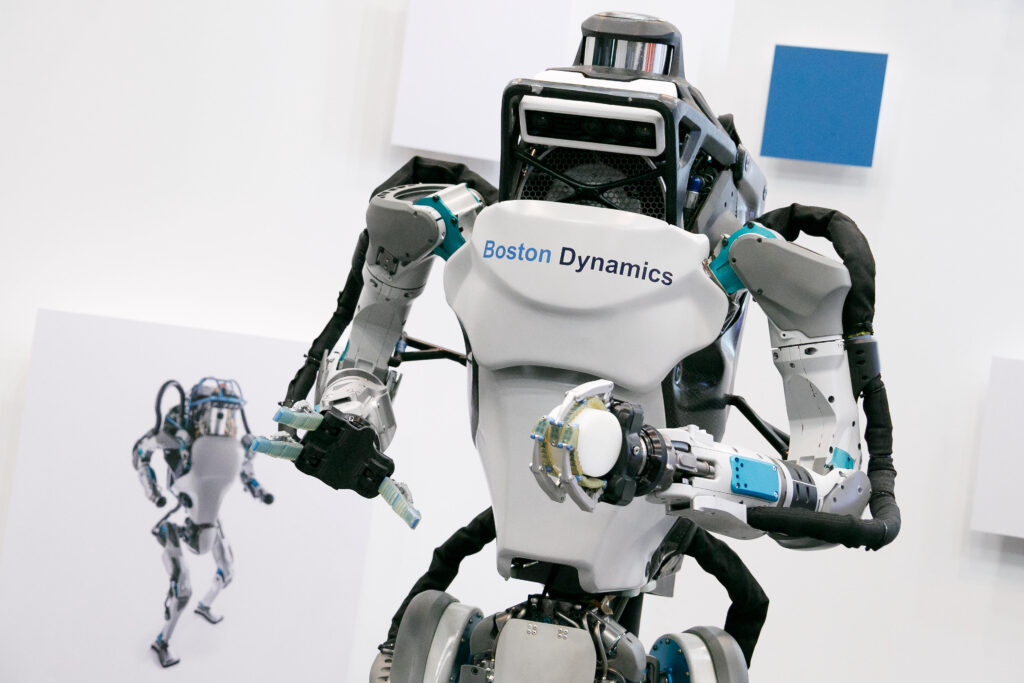Boston Dynamics is one of the premier humanoid robot research companies in the world. It started in 1992 building 3D flight simulators for pilot training. By 2005, they had moved on to introduce their first autonomous robot known as “Big Dog”, designed to carry a 340-pound payload up a 35-degree incline. This “dog” was intended for military use to help soldiers bring bigger payloads into the field. This branch of development was ultimately too noisy for any sort of stealthy military uses. Though it did eventually evolve though several generations to become the “Spot” commercial dog robot.
TACKLING BIPEDALISM
Taking a different approach in 2009 they created “Petman”, their first humanoid robot at 6’ 2” tall and 330 pounds. They decided to use hydraulics for movement and an electric motor to drive the hydraulics, both for quieter operation and to exploit the high-power density of hydraulics. In 2013 this program was renamed the Atlas project and their baseline model became more compact at around five feet tall and 190 pounds. It also had a respectable running speed of 5.6 mph. The initial thought was that it would be used as a search and rescue robot. However, as the program advanced the charter with Atlas was to use it as a research platform. One of the key goals with this new mission was to maximize its agility and balance so that it could do things like run a parkour course and do gymnastic moves like back flips. The team was striving for fluid human-like movement.

HYDRAULICS FOR SMOOTH AND QUIET OPERATION
Powering the Atlas platform is one of the world’s most compact mobile hydraulic systems. A custom battery, valves, and a compact hydraulic power unit enable Atlas to deliver high power to any of its 28 hydraulic joints. This gives it remarkable fluidity of movement for impressive feats of mobility. For vision it uses lidar coupled with stereo cameras. As the platform has developed, movement challenges have become more complex, but also smoother and more balanced in execution.
SEARCH AND RESCUE OR SEARCH AND DESTROY?
Though DARPA’s first projects were all designed with the needs of the military in mind, these days the picture they paint is more of a “helpful companion” rather than mechanical overlord. To accentuation that point, in 2015 DARPA mounted a challenge for humanoid bipedal robots, that was inspired by the Fukushima nuclear disaster. The challenge was very much built around accessing some difficult areas and performing tasks in tight quarters. The team that could run their robot through all of the tasks the quickest would win $2m with second place taking $1m and third place would get $500k. The tasks that they set for the robots were as follows:
- Drive a utility vehicle at the site.
- Travel dismounted across rubble.
- Remove debris blocking an entryway.
- Open a door and enter a building.
- Climb an industrial ladder and traverse an industrial walkway.
- Use a tool to break through a concrete panel.
- Locate and close a valve near a leaking pipe.
- Connect a fire hose to a standpipe and turn on a valve.
These mimic tasks that a first responder might need to do, so clearly the emphasis was directed toward search and rescue capabilities. Still, there is lingering concern that the agility and performance of Atlas, SPOT and other Boston Dynamics robots makes them the ideal platform for deploying weapons. After all, ATLAS’s hands boast fine motor skills, so it wouldn’t take much if any modification of conventional weapons to turn the helpful companion into a skillful killer.
A FINAL WORD
Boston Dynamics takes a strong stand on this issue on their web site. Regarding potential weaponizing of their robots, “All buyers are prohibited from such use as stated clearly in our Terms and Conditions of Sale, which prohibit weaponizing our robots. If our products are being used for harm, we will take appropriate measures to mitigate that misuse.”
Having robot companions or helpers would clearly have some benefit for mankind. And Boston Dynamics’ guiding principles are directed toward this goal. Let’s hope their vision prevails. I think they’ve got a good start.
